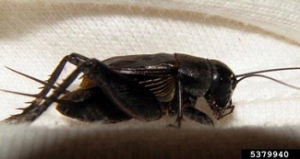How to Keep Outdoor Crickets From Getting Inside
By Chris Williams on July 6, 2015.
A Field Cricket
We moved into our house 4 years ago and every summer we’ve had a terrible problem with these black crickets, both outside and inside. What’s drawing them to our house and what’s the best way to get rid of them? Thanks. E.G., Natick, MA
We sometimes refer to crickets as “perimeter pests,” because they are most often found around the outside foundation of buildings. They like this area around your home because it’s often damp (from accumulated mulch or poor drainage), and has decaying vegetable matter (mulch or leaves), and plenty of protected hiding spots.
We have three types of crickets in our region that get into houses: field cricket, house cricket, and camel cricket. The dark brown to black field crickets that you’re talking about will feed on most anything. Outside, they are feeding on decaying vegetation, including garden fruits and vegetables, and insects, among other things. Inside, they will eat garbage, or any people or pet foods they can find. They sometimes damage fabrics or papers that have been soiled with food, sweat, or other organic materials (see Do Crickets Do Any Damage Inside?).
Controlling Crickets Outside
You can reduce the numbers of crickets (of any type) around the perimeter of your home by cleaning up items that provide shelter such as piles of leaves, stones, wood, or groundcover plants, weeds, or mulch. Correct any drainage problems that keep things damp around the foundation and reduce outside lights that attract crickets (see How to Keep Crickets Out of Your House).
Have Colonial Pest apply an insecticide treatment around the perimeter of your home. We have a Preventative Maintenance Program that provides you with two seasonal perimeter treatments and any follow-up service that you may require. Contact us for details.
Controlling Crickets Inside
Cricket migrations from outdoors to indoors seem to occur most often in late summer/early fall as cooler weather encourages crickets to look for places to spend the winter. Once they get inside, they usually remain on lower or basement levels, or other parts of the home with high humidity.
Indoor insecticide control is usually not recommended since field crickets don’t live long in dry indoor air anyway and finding that elusive, chirping cricket is difficult (see That Annoying Chirping! for places to look). House crickets can survive and even reproduce indoors, but that’s another cricket and another blog. Indoor field cricket control should rely on a combination of effective outdoor control and sealing of openings to keep crickets from getting in.
If you’re diligent about reducing crickets outside, there should be many fewer crickets trying to get inside. Check your home for openings where crickets can enter, particularly on the lowest level. Common entry points are under doors, especially garage doors, around windows and window wells, through vents, or where utility lines enter. At Colonial, we have pest exclusion experts who can find and seal these openings for you. Give us a call today!
Jessica Louque, Smithers Viscient, Bugwood.org
